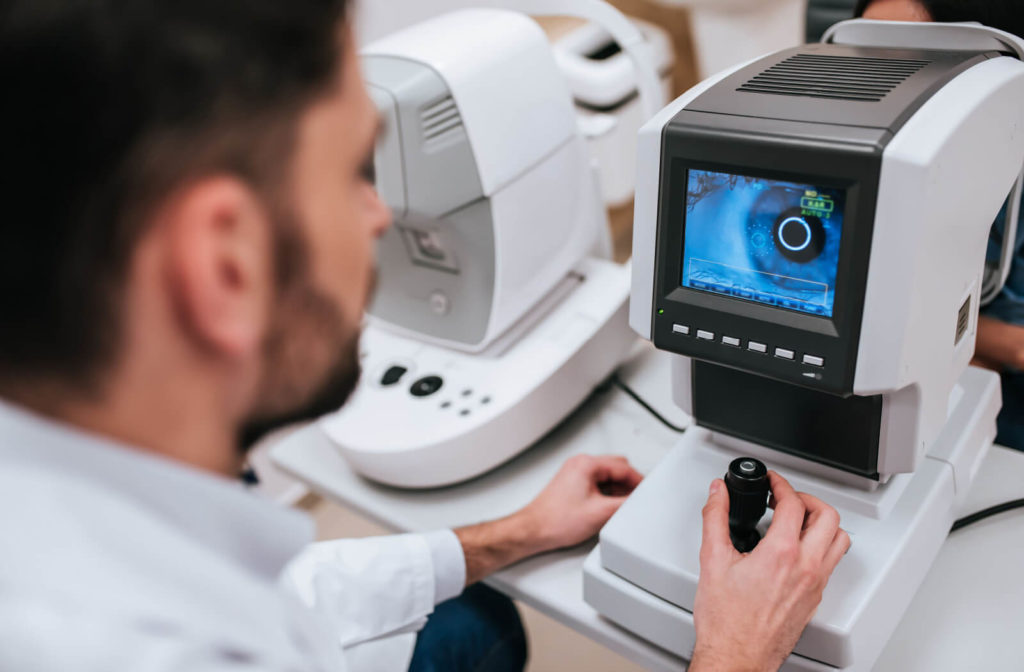Your optometrist does much more than just determine your prescription for eyeglasses or contact lenses during a comprehensive eye exam.
He or she will also examine your eyes for common and rare eye diseases, evaluate how well your eyes work together as a team, and look for signs of a variety of potentially serious health conditions that affect other parts of the body.
The eyes, with their delicate structures such as nerves, blood vessels, and connective tissues, can provide early warning signs of a variety of serious health problems. This is important for patients because early detection of diseases is often the key to avoiding serious consequences.
Health Risks Found in Eye Exams
Your eyes are windows into the workings of your body’s blood vessels, nerves, and connective tissues. Eye problems are frequently the first signs of diseases that are lurking elsewhere.
A comprehensive eye exam can detect a variety of underlying health conditions, ranging from high blood pressure and diabetes to certain types of cancer.
Medication Toxicities
Several drugs are toxic to the retina and optic nerve. Toxic symptoms include red eyes, scratchy corneas, and conjunctivitis.
Lupus
You may have dry eye disease if your eyes are constantly dry. You could, however, have lupus, an inflammatory disease. Lupus is an autoimmune disease where your body attacks healthy tissues.
An optometrist may be concerned about lupus if they notice swelling in the white part of your eyes during an eye exam.
Stroke
Retinal blood vessels can become blocked or clotted. Blind spots or the sensation of a “curtain” closing over a person’s vision can result from these obstructions, which could point to an increased risk of stroke.
Cancer
Your optometrist may be able to help you with the detection process of many different forms of ocular cancer. These cancers frequently exhibit symptoms that can be detected during a thorough eye exam. Common types of cancer that can be detected in an eye exam include:
- Tissue Metastatic Breast Cancer
- Lymphoma
- Basal Cell Carcinoma
- Blood Melanoma
- Skin Retinoblastoma
At the very least, your optometrist may be able to advise you to consult with your doctor about the possibility of cancer.
Brain Tumors
Brain tumors can cause loss of peripheral vision, optic nerve changes, abnormal eye movements, double vision, or other vision changes depending on their location in the brain. A comprehensive eye exam, which includes tests of peripheral vision and eye muscle function, is frequently the first line of defense against a brain tumor.

High Blood Pressure
While examining your eyes, an optometrist may be able to detect high blood pressure. It frequently causes kinks and other issues with the blood vessels in the back of the eye.
High blood pressure can lead to a variety of eye problems. Glaucoma is one of the most serious eye conditions caused by high blood pressure.
Diabetes
Diabetic retinopathy is distinguished by the presence of tiny blood vessels in the retina that leaks yellow fluid or blood. Even before a person is diagnosed with diabetes, this disease can manifest in eye tissue. Early detection can help people avoid permanent vision loss and other serious complications.
Multiple Sclerosis
Multiple sclerosis, a degenerative nervous system disease, can cause optic nerve inflammation. This inflammation is often accompanied by severe blurred vision, painful eye movement, or even double vision.
Thyroid Disease
If your eyeballs are bulging or protruding from eyelids that appear to be retracting, your optometrist will suspect hyperthyroidism, which is frequently caused by Grave’s Disease. The tissues and muscles around the eye are affected, and symptoms may include blurry vision, vision loss, or dry eyes.
Heart Disease
Optometrists may be able to detect early signs of heart disease in the eyes. If your eye doctor carefully examines the retina with an imaging tool called an optical coherence tomographer (OCT), he or she may be able to detect microscopic marks left by an eye stroke.
These marks can appear in the retinas of healthy people, but there are more marks in people with heart disease.
Sickle Cell Disease
Sickle cell disease, a genetic blood disorder, causes stiff, comma-shaped red blood cells that can obstruct blood flow throughout the body.
This disease can cause a wide range of ocular changes, from redness and burst blood vessels on the eye’s surface to severe hemorrhages and even retinal detachment within the eye.
Vitamin A Deficiency
Night blindness and dry eyes are common conditions in vitamin A deficient people. This is because vitamin A aids in the production of moisture in the eyes, which keeps them lubricated.
A lack of vitamin A may result in night blindness due to a lack of certain pigments required for the proper function of the retina. Vitamin A deficiency is the leading cause of childhood blindness worldwide.
Stay Educated on Your Ocular Health
A comprehensive eye exam is a crucial component of preventive healthcare and examines the entire eye and visual system in addition to your prescription.
Your optometrist will advise you to get additional testing from a specialist or your primary care provider to be certain of what’s going on when an eye exam indicates a potential health issue. Schedule your comprehensive eye exam with Dr. Henslick Vision Center today to get a complete picture of your vision and health.




